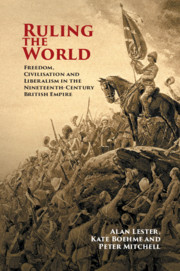Book contents
- Ruling the World
- Ruling the World
- Copyright page
- Dedication
- Contents
- Figures
- Maps
- Acknowledgements
- Introduction
- Part I 1838: The Year of Freedom
- Part II 1857: The Year of Civilisation
- 7 Setting the Scene: Hubris and Crisis
- 8 ‘A Struggle of Life and Death’
- 9 A New Imperial Government
- Conclusion to Part II: An Empire of Civilisation?
- Part III 1879: The Year of Liberalism
- Appendix: Cast of Characters
- Notes
- Index
Conclusion to Part II: An Empire of Civilisation?
from Part II - 1857: The Year of Civilisation
Published online by Cambridge University Press: 17 December 2020
- Ruling the World
- Ruling the World
- Copyright page
- Dedication
- Contents
- Figures
- Maps
- Acknowledgements
- Introduction
- Part I 1838: The Year of Freedom
- Part II 1857: The Year of Civilisation
- 7 Setting the Scene: Hubris and Crisis
- 8 ‘A Struggle of Life and Death’
- 9 A New Imperial Government
- Conclusion to Part II: An Empire of Civilisation?
- Part III 1879: The Year of Liberalism
- Appendix: Cast of Characters
- Notes
- Index
Summary
The events which had their genesis around the year 1857 saw some 40 000 amaXhosa starve to death on the borders of the Cape Colony; around 2300 British and allied soldiers and 30 000 Chinese killed in the Second Opium War, and some 3000 British and more than 100 000 Indian soldiers killed in the Indian Uprising and its aftermath. Hundreds of thousands of civilian subjects of colour, whom the colonial authorities never counted, were killed by British forces in the ‘Devil’s wind’ in India and the shelling and ransacking of Chinese towns and cities. What can only be described as British imperial hubris had played a major role in bringing about each of these simultaneous crises. These casualties were the unacknowledged cost of Britain’s newly assertive, mid-Victorian, civilising mission – a mission more usually associated with the endeavours of the anti-slavery missionary-explorer David Livingstone, to whom we will return in Part III.
- Type
- Chapter
- Information
- Ruling the WorldFreedom, Civilisation and Liberalism in the Nineteenth-Century British Empire, pp. 269 - 272Publisher: Cambridge University PressPrint publication year: 2021

